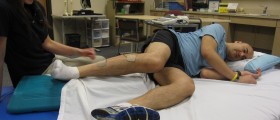
Sciatica is the term used to describe any pain that results from compression or irritation of the sciatic nerve. Sciatic nerve is a very long nerve that runs from the lower back, through the buttocks, back of the thighs and calves and ends at the feet.
Sciatica nerve pain
Whenever this nerve is pressed, pinched or irritated, the pain, which can be mild, moderate or severe, radiates from the back of the pelvis down the back of the legs.
The most common causes of sciatica nerve pain include herniated disk, spinal stenosis, injury, and, less commonly, infection and tumors.
Types of sciatica nerve pain
There are two main types of sciatica - acute and chronic. In acute sciatica, the pain is short-term and lasts no more than six weeks, while in chronic form it is persistent and long-lasting, longer than six weeks.
Acute sciatica usually goes away on its own without the need of any specific or elaborate treatment. Pain killers and hot or cold compresses usually help with the pain. Chronic sciatica, on the other hand, requires medical evaluation and it is usually treated either through specific exercise regime, under the supervision of a physical therapist, or, in more severe cases, through surgery.
Symptoms of sciatica
Sciatica is very different from common, general back pain. In fact, it hardly affects the back at all. It does start at the lower back, at the back side of the pelvis, and radiates through the buttocks, back of the thighs and calves. Other that the pain, sciatica symptoms include tingling or burning sensation, needles and pins, muscle weakness and numbness of some parts of the leg, especially the foot.
Causes of sciatica
As mentioned above, herniated or slipped disk is one of the main causes of sciatica pain. The spine is made of vertebrae, discs and nerves. The discs are made of hard fibrous tissue and they contain a gel-like substance inside. When a disk slips or ruptures, the gel seeps out, which may bulge and press against the sciatic nerve, causing sciatica symptoms.
Another common cause of sciatica is spinal stenosis, which means that nerve passages in the spine become narrow. It happens when discs, bones or ligaments press the nerve, causing pain and numbness. This usually happens with age and there are not many young people suffering from spinal stenosis.
Sciatica is also common in pregnancy. As the mother’s weight increases in order to host the fetus, and as the fetus grows in the uterus, the abdominal area expands and presses on the sciatic nerve. This is particularly common in the third trimester.











-Causes,-Symptoms,-Diagnosis,-Treatment_f_280x120.jpg)





Your thoughts on this
Loading...